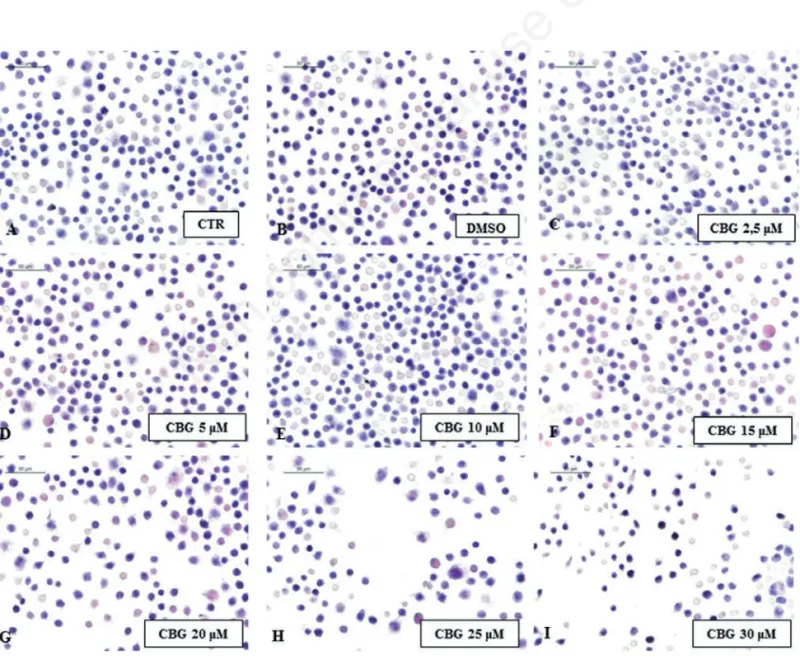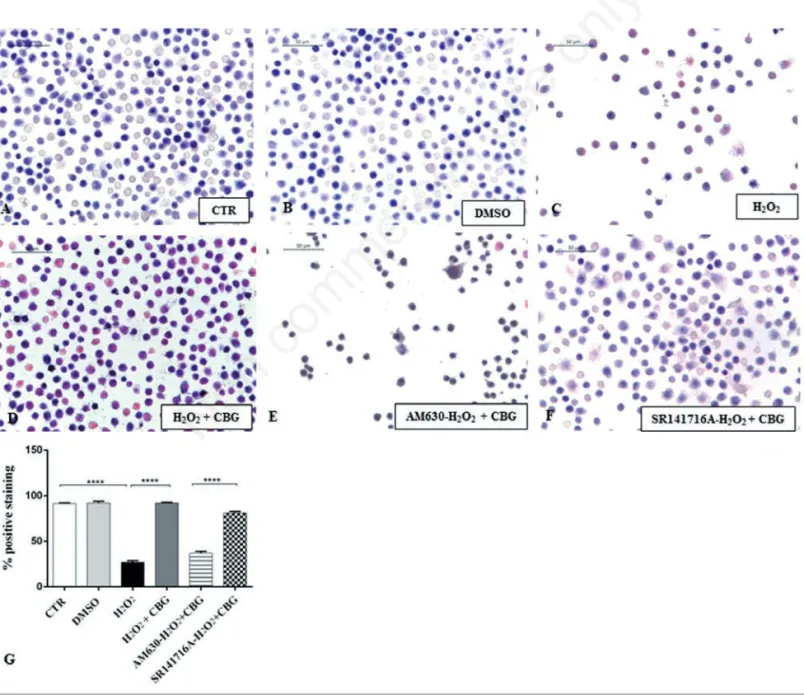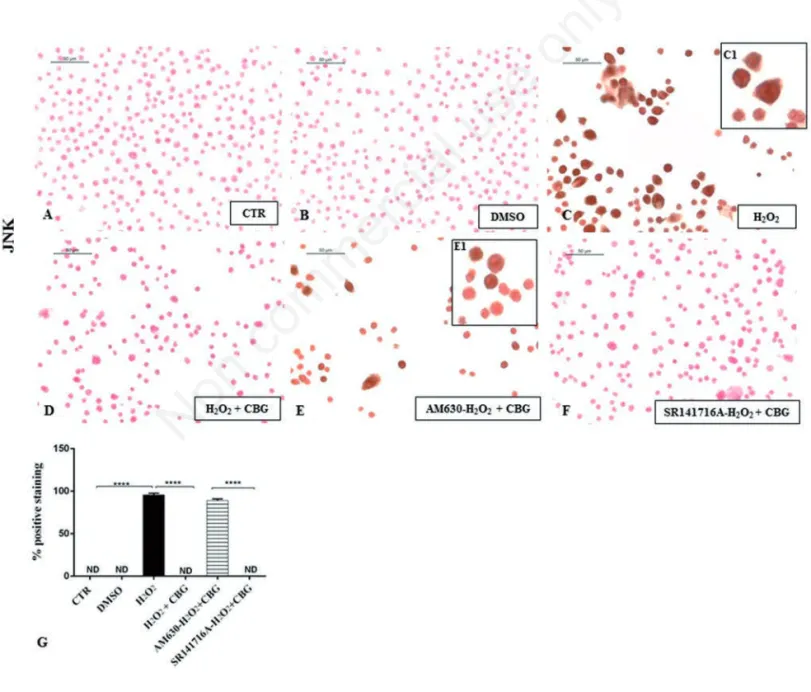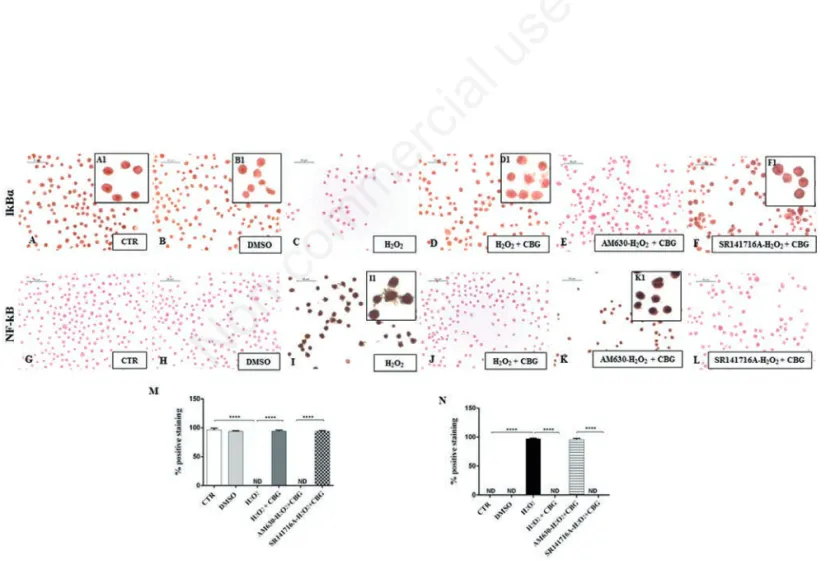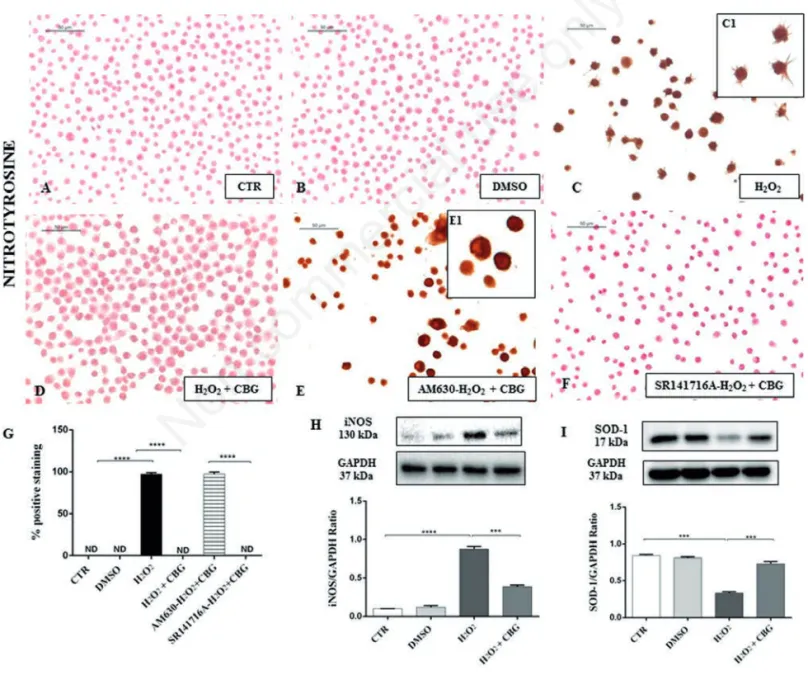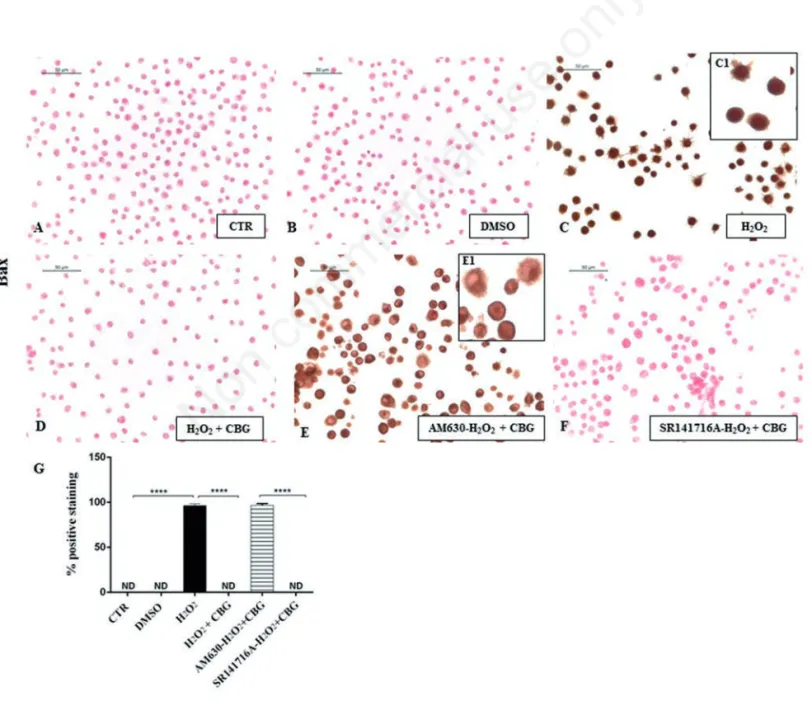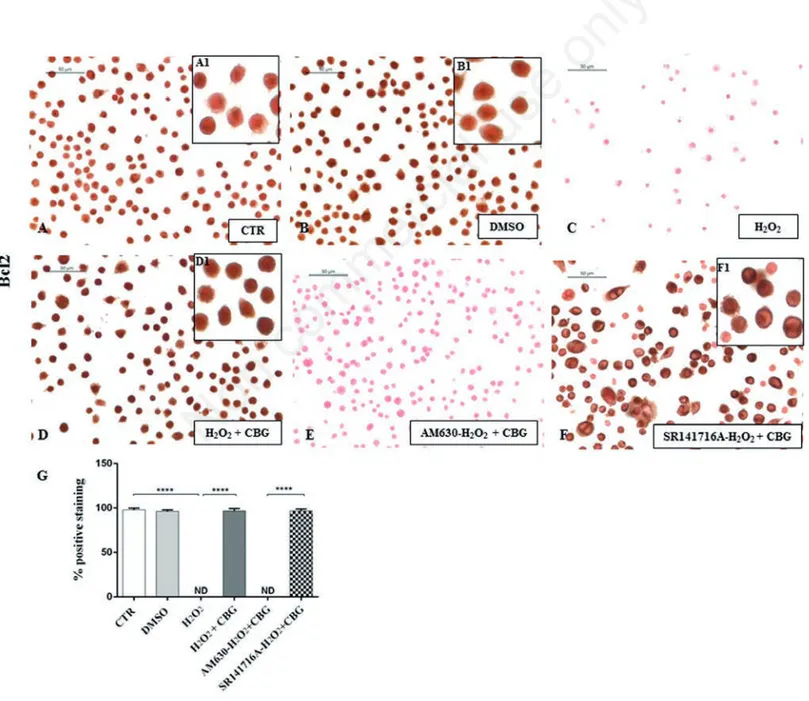Cannabinoid CB2 receptors are
involved in the protection
of RAW264.7 macrophages
against the oxidative stress:
an
in vitro study
Sabrina Giacoppo,1
Agnese Gugliandolo,1Oriana Trubiani,2 Federica Pollastro,3 Gianpaolo Grassi,4 Placido Bramanti,1Emanuela Mazzon1 1IRCCS Centro Neurolesi “Bonino-Pulejo”, Messina
2Stem Cells and Regenerative Medicine Laboratory, Department of Medical, Oral and Biotechnological Sciences, University “G. d’Annunzio”, Chieti-Pescara
3Department of Pharmaceutical Sciences, University of Eastern Piedmont “Amedeo Avogadro”, Novara 4Research Centre for Industrial Crops, Council for Agricultural Research and Economics (CREA-CIN), Rovigo, Italy
Abstract
Research in the last decades has widely investigated the anti-oxidant properties of natural products as a therapeutic approach for the prevention and the treatment of oxidative-stress related disorders. In this context, several studies were aimed to eval-uate the therapeutic potential of phyto-cannabinoids, the bioactive compounds of
Cannabis sativa. Here, we examined the
anti-oxidant ability of Cannabigerol (CBG), a non-psychotropic cannabinoid, still little known, into counteracting the hydrogen peroxide (H2O2)-induced oxidative stress in
murine RAW264.7 macrophages. In addi-tion, we tested selective receptor antago-nists for cannabinoid receptors and specifi-cally CB1R (SR141716A) and CB2R (AM630) in order to investigate through which CBG may exert its action. Taken together, our in vitro results showed that CBG is able to counteract oxidative stress by activation of CB2 receptors. CB2 antag-onist pre-treatment indeed blocked the pro-tective effects of CBG in H2O2 stimulated
macrophages, while CB1R was not involved. Specifically, CBG exhibited a potent action in inhibiting oxidative stress, by down-regulation of the main oxidative markers (iNOS, nitrotyrosine and PARP-1), by preventing IκB-α phosphorylation and translocation of the nuclear factor-κB (NF-κB) and also via the modulation of MAP kinases pathway. On the other hand, CBG
was found to increase anti-oxidant defense of cells by modulating superoxide dismu-tase-1 (SOD-1) expression and thus inhibit-ing cell death (results focused on balance between Bax and Bcl-2). Based on its anti-oxidant activities, CBG may hold great promise as an anti-oxidant agent and there-fore used in clinical practice as a new approach in oxidative-stress related disor-ders.
Introduction
The oxidative stress is induced by an imbalanced redox states, involving either excessive generation of reactive oxygen species (ROS) or dysfunction of the antiox-idant system.1It is widely recognized that
oxidative stress is the major cause of devel-opment of many chronic diseases, such as aging, cancer, cardiovascular and neurode-generative diseases.2-4 Several line of
evi-dence have shown that the excessive pro-duction of ROS from metabolism or exoge-nous intake, can lead to damage of biomol-ecules, including lipids, proteins and nucle-ic acids, thereby affecting normal physio-logical functions.5 The brain is one of the
organs especially vulnerable to the effects of ROS because of its high oxygen demand and its abundance of peroxidation-suscepti-ble lipid cells.2
Over the last years, there has been an increasing attention to antioxidants from natural compounds without undesirable side effects and toxicity. In this context, phyto-cannabinoids the bioactive compounds of
Cannabis sativa, that do not produce
psy-chotropic effects, such as cannabidiol (CBD), cannabigerol (CBG), Δ9
tetrahydro-cannabivarin (Δ9THCV) and cannabidivarin
(CBDV) were considered of special interest as novel therapeutic agents especially in the treatment of diseases involving both inflam-mation and oxidative stress.6 Generally,
cannabinoids exert many of their beneficial effects by binding cannabinoid (CB) recep-tors. To date, two types of receptors, both belonging to the family of G-protein cou-pled receptors (GPCRs), have been identi-fied. CB1 receptors are expressed mainly on neurons and glial cells in various parts of the brain, CB2 receptors are found predom-inantly in the cells of immune system7.
Moreover, there is increasing evidence sup-porting the existence of additional cannabi-noid receptors (no-CB1 and no-CB2) in both central and peripheral system, identi-fied in CB1 and CB2-knockout mice.8To
date, there are few studies about the phar-macological actions of CBG. The small body of in vitro evidence suggests that CBG
exhibits a pharmacological profile relative-ly similar to cannabidiol (CBD) regarding its CB receptors activities,6,9 however its
affinity for CB receptors has not been fully clarified. Although, CBG was proven to exert anti-inflammatory and anti-oxidant effects, the molecular mechanism of action is not yet known. Borrelli and co-authors10
demonstrated both of these properties in an experimental model of inflammatory bowel disease. CBG was found to reduce nitric oxide production and consequently to
pro-Correspondence: Emanuela Mazzon, IRCCS Centro Neurolesi "Bonino-Pulejo", Via Provinciale Palermo, Contrada Casazza, 98124 Messina, Italy.
Tel. +39.090.60128708; Fax +39.090.60128850. E-mail: [email protected]
Key words: RAW264.7 macrophages; immunohistochemistry; cannabigerol; oxida-tive stress; apoptosis.
Contributions: SG, manuscript writing, in
vitro studies, molecular biology analysis and
the statistical analysis; AG, helped with in
vitro experiments and molecular biology; OT,
helped revising the manuscript critically for important intellectual content; FP, isolation of CBG performing; GG, provided the Cannabis
sativa L. plant, derived from greenhouse
culti-vation at CREA-CIN, Rovigo (Italy); PB, experiments conception and design, helped revising the manuscript; EM, substantial con-tributions to the conception and design of study, immunohistochemical analysis per-forming, manuscript revision. All authors read and approved the final version of the manu-script.
Acknowledgments: the authors would like to thank Prof. Giovanni Appendino (University of Eastern Piedmont "Amedeo Avogadro", Novara, Italy), for his technical assistance and precious contribution during manuscript drafting. Funding: this study was supported by current research funds 2016 of IRCCS "Centro Neurolesi Bonino-Pulejo", Messina, Italy. Conflict of interest: the authors declare no conflict of interest.
Received for publication: 3 November 2016. Accepted for publication: 21 December 2016. This work is licensed under a Creative Commons Attribution-NonCommercial 4.0 International License (CC BY-NC 4.0).
©Copyright S. Giacoppo et al., 2017 Licensee PAGEPress, Italy
European Journal of Histochemistry 2017; 61:2749 doi:10.4081/ejh.2017.2749
Non
commercial
use
tect macrophages against oxidative stress by binding CB2 receptors.10In addition, it
was demonstrated that CBG was able to inhibit COX-2 enzymes in human colon adenocarcinoma cell line HT29.11CBG was
found also to suppress lipopolysaccharide-induced (LPS) release of pro-inflammatory cytokines and prostaglandin E2 in primary microglial cells.12A recent study of 2015,
suggests CBG as a potential candidate for pharmacological therapies in a experimen-tal model of Huntington’s disease. Specifically, authors demonstrated that CBG by activating the peroxisome prolifer-ator-activated receptor gamma (PPARγ) in striatal cells was able to alleviate
sympto-matology and neuroinflammation.13
Moreover, by using a murine model of Huntington’s disease, it was demonstrated that the treatment with VCE-003, a CBG quinone derivative, inhibited the upregula-tion of pro-inflammatory markers and
improved antioxidant defenses in the brain through PPARγ activation.14
In the present study, we investigated whether treatment with purified CBG may counteract oxidative stress induced by hydrogen peroxide (H2O2) in a murine
macrophage cells line. Specifically, we have chosen RAW 264.7 macrophages since it was widely demonstrated that fol-lowing toxicant exposure, they are able to trigger mechanisms associated with over-production of pro-inflammatory mediators as well as over-production of ROS.15-17
Therefore, this cell line provides an excel-lent model for screening anti-oxidant drugs and consequent evaluation of inhibitors of the signaling pathways that lead to induc-tion of oxidative mediators. In addiinduc-tion, in order to understand whether the inhibition of oxidative stress by CBG treatment could be mediated by CB receptors, we have pre-treated RAW 264.7 macrophages with
selective receptor antagonists for cannabi-noid receptors and specifically CB1R (SR141716A) and CB2R (AM630) before CBG administration.
Materials and Methods
Plant material
Cannabis sativa var. Carma was
derived from a greenhouse cultivation at CREA-CIN, Rovigo (Italy), where a vouch-er specimen is kept. The plant matvouch-erial was collected in November 2010 and was sup-plied by Dr. Gianpaolo Grassi (CREA, Rovigo, Italy). The manipulation of the plant was done in accordance with its legal status (Authorization SP/101 of the “Ministero della Salute”, Rome, Italy).
Figure 1. Cytotoxicity of CBG. Eosin/hematoxylin (E&H) staining of untreated RAW 264.7 cells (CTR) (A), incubated with DMSO (B), with CBG 2.5 µM (C), 5 µM (D), 10 µM (E), 15 µM (F), 20 µM (G), 25 µM (H) and 30 µM (I).
Non
commercial
use
General experimental procedures
1H NMR spectra were measured on
JEOL ECP 300- 300 MHz spectrometer. Chemical shifts were referenced to the residual solvent signal (CDCl3: δH 7.26).
Reverse phase (RP) C-18 (POLYGOPREP 60-30 C18) was used for the removal of waxes and pigments. Silica gel 60 (70-230 mesh) was used for gravity column chro-matography. CBG purification was moni-tored by TLC on Merck 60 F254 (0.25 mm) plates, which were visualized by UV inspection and/or spraying with 5% H2SO4
in ethanol and heating.
Extraction and isolation of CBG
One kg of dried, powdered flowered aerial parts were heated at 120°C for 2.5 h to decarboxylate precannabinoids and then extracted exhaustively with acetone (2x9 L) in a shaker. Removal of the solvent left a
black resinous residue (74 g, 7.4%), which was dissolved in MeOH (30 mL/g of extract) and filtered through RP C-18 silica gel for the removal of waxes and pigments. The evaporation of methanol afforded 36 g of a dark-green extract that was further purified by gravity column chromatography on silica gel (75 g, petroleum ether-EtOAc, 8:2, as eluent) to afford 5 g of a yellow oil then crystallized with petroleum ether to give 3 g of pure CBG (0.3%). Pure CBG was stored at -8°C.
Cell culture conditions and drug
treatment
The murine macrophage cell line RAW 264.7 was acquired from the “Centro sub-strati cellulari, Istituto Zooprofilattico Sperimentale della Lombardia e dell’Emilia” (Italy). Macrophage cells were cultured in monolayer using RPMI-1640 medium (Carlo
Erba, Cornaredo, Italy) containing 10% fetal bovine serum (FBS) (Sigma-Aldrich Co. Ltd., St. Louis, MO, USA). The cells were grown in logarithmic phase at 37°C in a moisturized atmosphere of 5% CO2and 95%
air. Experiments were performed with cells not exceeding 25 passages. In order to assess the potential cytotoxic effects of CBG, macrophage cells were grown in RPMI-1640 medium containing 10% of FBS until 70-80% confluence (4×105cells/cm2) followed
by 24 h of incubation at 37°C with CBG at following concentration range (μM): 2.5, 5, 10, 15, 20, 25 and 30. Moreover in order to evaluate the effect of H2O2 time-dependent,
cells were stimulated with H2O2 (500 μM;
Sigma-Aldrich) for 3, 6 and 9 h by adding directly H2O2 (500 μM; Sigma-Aldrich) into
cell culture medium. Then, cells were either fixed or harvested for further analyses. For drug treatment, cells were grown until
70-Figure 2. Curve of cytotoxicity of H2O2. RAW 264.7 cells incubated with H2O2(500 µM) for 3 h (A), 6 h (B) and 9 h (C). The graph (D) shows the percentage of positive staining for total cells area. *P<0.0321 3 h vs 6 h; #P=0.0174 3 h vs 9 h.
Non
commercial
use
80% confluence (4×105cells/cm2) followed
by 2 h pre-treatment with CBG at 10 μM dose and then cells were stimulated with H2O2 (500 μM) for 6 h by adding directly
H2O2 into CBG-treated cell culture medium.
For antagonists study, before CBG adminis-tration, cells were incubated for 2 h with dif-ferent combinations of SR141716A (CB1 antagonist; 1 μM, Tocris Bioscience, Bristol, UK) or AM630 (CB2 antagonist; 100 nM, Tocris Bioscience) dissolved in 0.1% DMSO. Untreated cells (CTR) without H2O2
stimulation and RAW 264.7 treated with 0.1% DMSO (vehicle of CBG) were also included as controls. After H2O2stimulation,
the cells were either fixed or harvested for further analyses. All the experiments were made in triplicates and repeated for three independent times.
Eosin and hematoxylin staining
Morphological changes in the cells were assessed by hematoxylin and eosin staining (H&E) applying a standard proto-col. Briefly, cells on coverslips (10 mm; Thermo Scientific, Darmstadt, Germany) were fixed with 4% paraformaldehyde (Santa Cruz Biotechnology, Santa Cruz, CA, USA) for 15 min at room temperature. After washing with 1X PBS, cells were stained with Harris hematoxylin (Bio-Optica, Milan, Italy) for 1 min, rinsed with tap water, stained with eosin (Bio-Optica) for 5 min, and rinsed with distilled water. Then, coverslips were dehydrated with ethanol series (Carlo Erba Reagents, Val-de-Reuil, France; 50%, 70%, 80%, 96%, and 100%) and xylene (J.T. Baker, Deventer, The Netherlands). Coverslips
were mounted on microscope slides using mounting medium (Eukitt, Carlo Erba Reagents) and were allowed to dry. Microscopy was performed using light microscope (Leica DM 2000 combined with Leica ICC50 HD camera). All images are representative of three independent experiments.
Immunocytochemistry
Cells on coverslips (10 mm; Thermo Scientific) were fixed with 4% paraformaldehyde at room temperature for 15 min followed by phosphate buffered saline (PBS, pH 7.5) washes. Then, cells were incubated with 3% hydrogen peroxide (H2O2) at room temperature for 15 min to
suppress the endogenous peroxidase activi-ty. Following three washes with PBS, cells
Figure 3. Eosin/hematoxylin (H&E) staining. Eosin/hematoxylin (H&E) staining of untreated RAW 264.7 cells (CTR) (A), incubated with DMSO (B), H2O2 (C), H2O2+ CBG (D), AM630+ H2O2+ CBG (E) and SR141716A + H2O2+ CBG (F). The percentage of pos-itive staining was showed in graph (G), ****P<0.0001 CTR vs H2O2; ****P<0.001 H2O2 vs H2O2 + CBG; ****P<0.001 AM630 vs SR141716A.
Non
commercial
use
were blocked with horse serum +0.1% Triton X-100 for 20 min followed by incu-bation for overnight at 4°C with primary antibodies against examined proteins: JNK(1:100 Santa Cruz Biotechnology); anti-IκB-α (1:100 Cell Signaling Technology, Danvers, MA, USA); anti-NF-kB (1:100 Cell Signaling Technology); anti-Nitrotyrosine (1:250 Millipore, Billerica, MA, USA); anti-PARP-1 (1:100 Santa Cruz Biotechnology); anti-Bax (1:100 Santa Cruz Biotechnology); anti-Bcl-2 (1:100 Santa Cruz Biotechnology). After PBS wash, cells were incubated with biotinylated secondary antibody (1:200, Vector Laboratories, Burlingame, CA) and streptavidin AB Complex-HRP (ABC-kit from Dako, Glostrup, Denmark). The immunostaining was developed with the DAB peroxidase substrate kit (Vector
Laboratories) (brown color; positive stain-ing) and counterstaining with nuclear fast red (Vector Laboratories) (pink back-ground; negative staining).
The immunocytochemical assays were repeated three times and each experimental group was plated in duplicate. Totally, were assessed 6 coverslips for each antibody. In order to calculate the percentage of positive cell stained, the images were captured by using a light microscopy (LEICA DM 2000 combined with LEICA ICC50 HD camera) with an objective of 40X and subjected to densitometric analysis by using the soft-ware LEICA Application Suite ver. 4.2.0. Quantitative analysis was performed on 6 coverslips by covering about 90% of total area.
Protein extraction and western blot
analysis
Cells were harvested following 6 h of incubation with H2O2. After washing with
ice-cold PBS, the cells were lysed using buffer A [320 mM sucrose, 10 mM, 1 mM
EGTA, 2 mM EDTA, 5 mM NaN3, 50 mM
NaF, β-mercaptoethanol, and protease/ phosphatase inhibitor cocktail (Roche Molecular Systems, Inc., Branchburg, NJ, USA)] in ice for 15 min, followed by cen-trifugation at 1000 g for 10 min at 4°C. The supernatant was served as cytosolic extract. The pellet was further lysed using buffer B [150 mM NaCl, 10 mM Tris-HCl (pH 7.4), 1 mM EGTA, 1 mM EDTA, Triton x-100, and protease/phosphatase inhibitor cocktail (Roche)] in ice for 15 min, followed by cen-trifugation at 15,000 g for 30 min at 4°C.
Figure 4. Immunocytochemical analysis for JNK in untreated RAW 264.7 cells (CTR) (A), incubated with DMSO (B), H2O2(C, 40x; C1, 100x), H2O2+ CBG (D), AM630+ H2O2+ CBG (E, 40x; E1, 100x) and SR141716A + H2O2+ CBG (F). Densitometric analysis for JNK (G), ****P<0.0001 CTR vs H2O2; ****P<0.001 H2O2vs H2O2+ CBG; ****P<0.001 AM630 vs SR141716A; ND not detectable.
Non
commercial
use
The supernatant was collected and used as nuclear extract. Protein concentrations were calculated using the Bradford assay (Bio-Rad, Hercules, CA, USA). Twenty micro-grams of proteins were heated for 5 min at 95°C, resolved by 8% or 12% SDS-poly-acrylamide gel electrophoresis (SDS-PAGE) and transferred onto a PVDF
mem-brane (Immobilon-P, Millipore).
Membranes were blocked in 5% skim milk in PBS for 1 h at room temperature fol-lowed by overnight incubation at 4°C with particular primary antibodies. The follow-ing primary antibodies were used: iNOS (1:500; Cell Signaling Technology) and SOD-1 (1:1000; Abcam, Cambridge, UK). Then, membranes were washed in PBS 1X and incubated with HRP-conjugated anti-mouse or rabbit IgG secondary antibody (1:2000; Santa Cruz Biotechnology, Inc.) for 1 h at room temperature. To ascertain that blots were loaded with equal amounts of protein lysates, they were also incubated with antibody for GAPDH HRP Conjugated
(1:1000; Cell Signaling Technology). The relative expression of protein bands was visualized using an enhanced chemilumi-nescence system (Luminata Western HRP Substrates, Millipore) and protein bands were acquired and quantified with ChemiDoc™ MP System (Bio-Rad) and a computer program (ImageJ software) respectively. All blots are representative of three independent experiments.
Statistical data analysis
Statistical analysis of immunocyto-chemistry was performed using GraphPad Prism version 6.0 computer software pro-gram (GraphPad Software, La Jolla, CA, USA). The data were statistically analyzed by one-way ANOVA test and Bonferroni
post-hoc test for multiple comparisons. A
P-value less than or equal to 0.05 was con-sidered statistically significant. Results are reported as the mean ± SEM of N experiments.
Results
Morphological assessment in H
2O
2stimulated RAW 264.7 treated with
CBG
To investigate the cytotoxicity of CBG we treated the normal macrophage cells with CBG for 24 h at the following concen-trations (μM): 2.5, 5, 10, 15, 20, 25 and 30. We found that treatment with CBG at the concentrations range from 2.5 to 10 μM was not cytotoxic for the cells and did not cause cell death. Otherwise, starting from 15 until to 30 μM concentrations, CBG induced cell death in a dose dependent manner (Figure 1). Therefore, we have chosen 10 μM as opti-mal dose. Moreover, RAW 264.7 incubated with H2O2 (500 μM) showed only less cell
death after 3 h (Figure 2A). A severe cell death was noticed both at 6 h that at 9 h (Figure 2 B,C). Since no differences in cell death were found, we decided to incubate the cells with H2O2 (500 μM) for 6 h to
Figure 5. Immunocytochemical analysis for IκB-α in untreated RAW 264.7 cells (CTR) (A, 40x; A1, 100x), incubated with DMSO (B, 40x; B1, 100x), H2O2(C), H2O2+ CBG (D, 40x; D1, 100x), AM630+ H2O2+ CBG (E) and SR141716A + H2O2+ CBG (F, 40x; F1, 100x). Immunocytochemical analysis for NF-κB in untreated RAW 264.7 cells (CTR) (G), incubated with DMSO (H), H2O2(I, 40x; I1, 100x), H2O2+ CBG (J), AM630+ H2O2+ CBG (K, 40x; K1, 100x) and SR141716A + H2O2+ CBG (L). Densitometric analysis for IκB-α (M), ****P<0.0001 CTR vs H2O2; ****P<0.001 H2O2vs H2O2+ CBG; ****P<0.001 AM630 vs SR141716A. Densitometric analy-sis for NF-κB (N), ****P<0.0001 CTR vs H2O2; ****P<0.001 H2O2vs H2O2+ CBG; ****P<0.001 AM630 vs SR141716A.
Non
commercial
use
obtain a better management of the entire experiment. By H&E staining we found that the DMSO, vehicle of CBG, was not cyto-toxic for macrophage cells treated with it (Figure 3B). DMSO-treated cells displayed indeed normal morphology, indicated by the presence of ruffles as CTR cells (Figure 3A). On the contrary, morphological changes, including presence of surface smooth and shrinkage, were observed in H2O2
stimulat-ed RAW 264.7 macrophages (Figure 3C). Treatment with CBG instead attenuated these H2O2 triggered morphological features
(Figure 3D). In addition, by looking to the possible involvement of cannabinoid recep-tors CB1 and CB2, our data demonstrated that CBG acts via CB2R. More in detail, pre-treatment with AM630 (CB2
antago-nist) blocked the protective effect of CBG in H2O2-stimulated macrophages (Figure
3E), while SR141716A (CB1 antagonist) did not show inhibition towards the protec-tive role of CBG (Figure 3F).
Effects of CBG treatment on MAPK
signal-transduction pathway
By immunocytochemical analysis, we investigated the expression of JNK, a mito-gen-activated protein kinase (MAPK) that plays a key role in relaying extracellular signals from the cell membrane to the nucleus via a cascade of phosphorylation events.18As known, MAPKs can be
activat-ed also by the ROS production.19 Our
results confirmed a positive cytoplasmic
immunolocalization for JNK in
macrophages stimulated with H2O2 (Figure
4C). On the contrary, cells treated with CBG
showed negative cytoplasmic staining for JNK (Figure 4D), as observed in CTR cells (Figure 4A) and DMSO cells (Figure 4B). In addition, our results suggest that JNK modulation involved solely CB2R activa-tion. Pre-treatment with CB2 antagonist (AM630) indeed blocked the protective effect of CBG in H2O2 stimulated
macrophages as proven by positive immunolocalization for JNK (Figure 4E). Contrariwise, administration of CB1 antag-onist (SR141716A) exhibited negative staining for JNK (Figure 4F, see densito-metric analysis in Figure 4G), suggesting in this way that CB1R was not involved.
Figure 6. Immunocytochemical analysis for nitrotyrosine in untreated RAW 264.7 cells (CTR) (A), incubated with DMSO (B), H2O2 (C, 40x; C1, 100x), H2O2+ CBG (D), AM630+ H2O2+ CBG (E, 40x; E1, 100x) and SR141716A + H2O2+ CBG (F). Densitometric analysis for nitrotyrosine (G), ****P<0.0001 CTR vs H2O2; ****P<0.001 H2O2vs H2O2+ CBG; ****P<0.001 AM630 vs SR141716A. Western blot analysis for iNOS (H), ****P<0.0001 CTR vs H2O2; ***P=0.002 H2O2vs H2O2+ CBG. Western blot analysis for SOD-1 (I), ***P=0.0001 CTR vs H2O2; ***P=0.003 H2O2vs H2O2+ CBG.
Non
commercial
use
Effects of CBG treatment on IκB-α
degradation and NF-κB activation
in H
2O
2stimulated RAW 264.7
treated with CBG
NF-kB is a dimeric transcription factor present in the cytoplasm of cells in an inac-tive form due to its association with a class of inhibitory proteins called IκBs. Following different stimulus effects, like oxidative stress, IκB undergoes phosphory-lation and subsequently degraded, allowing NF-κB to translocate into the nucleus and induce gene expression.20 As expected, a
positive cytoplasmic staining for IκB-α and a in parallel a negative nuclear staining for NF-κB was observed in CTR cells (Figure 5 A,G) as well as in DMSO group (Figure 5 B,H). Upon stimulation with H2O2, cells did
not stain for IκB-α in cytoplasm (Figure 5C), but showed a marked nuclear positive staining for NF-κB (Figure 5I). CBG administration significantly increased the degree of cytoplasmic positive staining for IκB-α (Figure 5D) and reduced nuclear pos-itive staining for NF-κB in H2O2-stimulated
cells (Figure 5J). Moreover, the protection of CBG can be attributed only to CB2R. The pre-treatment with AM630 (Figure 5 E, K) indeed was found to block the efficacy of CBG, restoring a condition similar to that observed in cell incubated with H2O2.
Pre-treatment with SR141716A (Figure 5 F,L, see densitometric analysis in Figure 5 M,N) on the contrary did not altered the efficacy of the CBG treatment, suggesting that CB1R did not affect this signaling.
CBG inhibits the production of
oxidative stress markers in H
2O
2stimulated RAW 264.7
We assessed the anti-oxidative effects of CBG by evaluating the expression of some oxidative damage markers in the mouse RAW 264.7 cells stimulated with
H2O2. Immunocytochemistry results
showed negative staining for nitrotyrosine in CTR cells (Figure 6A) as well as in DMSO cells (Figure 6B). Conversely, a dense positive staining for nitrotyrosine in H2O2-stimulated cells was found (Figure
6C). CBG administration significantly inhibited the expression of nitrotyrosine (Figure 6D). Positive staining for macrophages pre-treated with AM630 (Figure 6E) and in concert a negative
stain-Figure 7. Immunocytochemical analysis for PARP-1 in untreated RAW 264.7 cells (CTR) (A), incubated with DMSO (B), H2O2(C, 40x; C1, 100x), H2O2+ CBG (D), AM630+ H2O2+ CBG (E, 40x; E1, 100x) and SR141716A + H2O2+ CBG (F). Densitometric analysis for PARP-1 (G), ****P<0.0001 CTR vs H2O2; ****P<0.001 H2O2vs H2O2+ CBG; ****P<0.001 AM630 vs SR141716A.
Non
commercial
use
ing for SR141716A pretreated ones (Figure 6F, see densitometric analysis in Figure 6G) in the same conditions, demonstrated the involvement only of CB2R and not of CB1R in the protective effects exhibited by CBG. In addition, Western blot data showed enhanced expression of another oxidative stress marker - iNOS - in H2O2-stimulated
cells, while CBG treatment significantly reduced its expression (Figure 7H) .
As a result of an increased production of radical species, cells have developed enzymatic cellular defense systems in the effort to detoxify these molecules and regenerate balanced redox homeostasis.21
Therefore, we investigated the expression of SOD-1, chosen as anti-oxidant defense marker. Western blot analysis showed a basal expression of SOD-1 in CTR and DMSO cell groups. H2O2stimulated RAW
264.7 showed a reduced level expression of
SOD-1, increased instead by administration of CBG (Figure 6I). Moreover, among the first cellular responses to DNA damage is the production of Poly (ADP-ribose) poly-merase (PARP), a marker of oxidative stress synthesized in large quantities by PARP enzymes, whose activity increases when cells are subjected to damage.22 By
immunocytochemical evaluation we assessed the presence of nuclear PARP-1 activation, showing negative nuclear stain-ing for PARP-1 in CTR cells and DMSO cells (Figure 7 A,B, respectively). Conversely, a dense nuclear positive stain-ing for PARP-1 observed in H2O2
-stimulat-ed cells (Figure 7C), was totally delet-stimulat-ed by CBG administration (Figure 7D). Anti-oxi-dant effects exhibited by CBG are due to involvement of CB2R and not of CB1R. Immunocytochemical results obtained from cells pre-treated with AM630 (Figure 7E)
indeed were compatible with what has been observed in cell incubated only with H2O2,
suggesting that use of CB2R antagonist blocked the activity of CBG. Pre-treatment with SR141716A (Figure 7F, see densito-metric analysis in Figure 7G) on the con-trary did not affect the anti-oxidant effects of CBG, thus we can assess that CB1R was not involved in this cellular signaling.
CBG regulates apoptosis pathway in
H
2O
2stimulated RAW 264.7
Finally, as the close link between ROS and apoptosis is well known, we evaluated whether CBG could potentially exert apop-tosis regulatory functions in RAW cells stimulated with H2O2. By
immunocyto-chemical analysis, we noticed a completely negative staining for Bax and a in parallel a notable positive staining for Bcl-2 in CTR cells (Figures 8A and 9A) as well as in
Figure 8. Immunocytochemical analysis for Bax in untreated RAW 264.7 cells (CTR) (A), incubated with DMSO (B), H2O2(C, 40x; C1, 100x), H2O2+ CBG (D), AM630+ H2O2+ CBG (E, 40x; E1, 100x) and SR141716A + H2O2+ CBG (F). Densitometric analysis for Bax (G). ****P<0.0001 CTR vs H2O2; ****P<0.001 H2O2vs H2O2+ CBG; ****P<0.001 AM630 vs SR141716A.
Non
commercial
use
DMSO ones (Figures 8B and 9B). On the
contrary, upon H2O2 stimulation,
macrophage cells showed positive staining for Bax and negative staining for Bcl-2 (Figures 8C and 9C). Moreover, CBG exhibited a significant ability in protecting the unbalance between Bax/Bcl-2 (Figures 8D and 9D). Also in this case, by pre-treat-ing cells with the cannabinoid receptor antagonists, we found that Bax/Bcl2 modu-lation is only mediated by the CB2R, not by CB1R (Figures 8 F and 9F, see densitomet-ric analysis in Figures 8 and 9G). The use of CB2R antagonist (AM630) blocked the protective effects of CBG as proven by pos-itive immunolocalization for Bax (Figure 8E) and negative staining for Bcl2 (Figure 9E). Administration of CB1 antagonist, in contrast, exhibited negative staining for Bax
(Figure 8F) with consequent positive stain-ing for Bcl2 (Figure 9F, see densitometric analysis in Figures 8G and 9G).
Discussion
Oxidative stress was first characterized by Sies23as “a disturbance in the
pro-oxi-dant to anti-oxipro-oxi-dant balance in favor of the oxidant species, leading to potential dam-age”. Oxidative stress is a crucial mecha-nism of the aging that can cause direct injury to the central nervous system. Free radicals affect indeed both the structure and function of neural cells, playing a key role into a wide range of neurodegenerative dis-eases, such as Parkinson’s disease and
Alzheimer’s disease.24There is currently a
debate whether oxidative stress is a cause or a consequence of these disorders, mostly due to a lack of understanding of the mech-anisms by which reactive oxygen species (ROS) act in both normal physiological and disease conditions.25Indeed, high
concen-trations of ROS can lead to impaired physi-ological functions through cellular damage of DNA, proteins, phospholipids, and other macromolecules.26On the other hand, low
doses of ROS are essential to cell signaling and regulation.27
In the last decades, a growing interest was aimed to identifying pharmacological inhibitors of oxidative stress mediators as a potential therapeutic strategy for preventing diseases correlated with oxidative stress. In this context, cannabinoids, the bioactive
Figure 9. Immunocytochemical analysis for Bcl2 in untreated RAW 264.7 cells (CTR) (A, 40x; A1, 100x), incubated with DMSO (B, 40x; B1, 100x), H2O2(C), H2O2+ CBG (D, 40x; D1, 100x), AM630+ H2O2+ CBG (E) and SR141716A + H2O2+ CBG (F, 40x, F1, 100x). Densitometric analysis for Bcl2 (G), ****P<0.0001 CTR vs H2O2; ****P<0.001 H2O2vs H2O2+ CBG; ****P<0.001 AM630 vs SR141716A.
Non
commercial
use
compounds of Cannabis sativa, exhibited a potent action in inhibiting oxidative and nitrosative stress, modulating the expres-sion of inducibile nitric oxide synthase (iNOS) and reducing the production of ROS.28,29In agreement with these findings,
we found that CBG, a non-psychotropic phytocannabinoid yet little known, was able to counteract oxidative stress in mouse macrophage cell line RAW264.7 stimulated with H2O2 by activation of CB2 receptors.
Upon stimulation, macrophage cells are involved in host defense and also they are able to increase the production of reactive oxygen and nitrogen species dramatically for a short period of time.15Our data showed that
the stimulation of macrophages with H2O2
induced cell morphological changes, such as appearance of surface smooth and shrink-age, reduced by CBG administration. It is well known that cannabinoids can exert mul-tiple pharmacological effects via CB1/CB2 receptors. As regards CB1R, it is not directly implied in the mechanism by which cannabinoids are able to protect cells from oxidative stress in vitro.30 Conversely, as
proven by Borrelli et al.,10CB2R is involved
in counteracting oxidative stress. Here, by pre-treating macrophages with selective receptor antagonists for CB1R (SR141716A) and CB2R (AM630), we clearly confirmed that CBG acts via CB2R. CB2 antagonist pre-treatment indeed blocked the protective effect of CBG in H2O2 stimulated
macrophages, while CB1R was not involved. This result is not surprising consid-ering that the CB1 receptors are localized mainly in the central nervous system,31while
CB2 receptors are expressed predominantly in cells of the immune system and in hematopoietic cells.32
To date, the molecular mechanism by which ROS cause oxidative damage is poor-ly characterized. Several line of evidence showed that H2O2 can induce or mediate the
activation of the mitogen-activated protein kinases (MAPK).33-36The MAPKs, a family
of ubiquitous proline-directed, protein-ser-ine/threonine kinases, including extracellu-lar signal-regulated kinases 1 and 2 (ERK1/2), p38, and c-Jun amino-terminal kinase (JNK), play an essential role in sequential transduction of biological signals from the cell membrane to the nucleus.37In
agreement with these findings, we reported direct evidence showing that stimulation with H2O2induced increased expression of
JNK in H2O2-stimulated macrophages,
whereas CBG administration by activating CB2R reduced significantly its expression. Moreover, it is widely accepted that MAP kinases can participate in the regula-tion of NF-κB transcripregula-tional activity, by
mediating downstream phosphorylation of IκB-α and subsequent activation of NF-κB.38NF-κB is generally inactive in
cyto-plasm due to the inhibition of IκB-α. In response to a wide range of stimuli, includ-ing ROS production, IκB-α is phosphorylat-ed by the enzyme IκB-α kinase, so that NF-κB is free to translocate into the nucleus and to promote the expression of a wide range of mediators involved not only in oxidative stress pathway, but also in inflammation and apoptosis molecular mechanisms. By immunocytochemical analysis we observed a negative immunolocalization for IκB-α and conversely dense positive immunolo-calization for NF-κB in H2O2-stimulated
macrophages. In attempting to coordinate the responses of macrophages against oxidative stimuli, CBG led to up-regulation of IκB-α and consequently down-regulation of NF-κB. CB2-dependent effects of CBG could be involved in upstream events that could affect intracellular oxidative path-ways. Furthermore, upon H2O2stimulation,
macrophages exhibit excessive accumula-tion of both nitric oxide (NO) and superox-ide anion (O2−), whose interaction results in
formation of toxic peroxynitrite (ONOO−).
Our results showed increased expression of two principal oxidative markers - iNOS and nitrotyrosine - in H2O2-stimulated
macrophages, inhibited instead by treat-ment with CBG. Our results are in accor-dance with the literature which reported that cannabidiol, another non-psychotropic cannabinoid, by blocking upstream MAP kinase and the transcription factor NF-κB activation, can suppress iNOS expression and NO production.28 Specifically, it was
demonstrated that inhibition of MAP kinase pathway was due to CB2R activation.39-41
Coherently with these data, we have found that CBG counteracts oxidative stress by inhibiting some key oxidative mediators via a CB2R dependent mechanism. Moreover, as a result of an increased production of rad-ical species, cells have developed enzymat-ic cellular defense systems, such as SOD, catalase, glutathione peroxidase, in the effort to detoxify these molecules and regenerate balanced redox homeostasis.
Here, we investigated the expression of SOD-1, that regulates oxidative response genes involved in resistance to oxidative stress and DNA damage repair.42 Our data
showed that stimulation with H2O2 in
RAW264.7 cells caused a decrease of SOD-1 expression, restored by CBG administra-tion. In this cellular cascade, another critical event is poly(ADP-ribose) polymerase-1 (PARP-1) activation following DNA dam-age.22Continuous or excessive activation of
PARP resulted in a substantial depletion of
ATP, leading to cellular dysfunction and cell death.43 Here, we demonstrated that
treat-ment with CBG inhibited PARP-1 activation in CB2R dependent manner. Moreover, radi-cal species production is implicated in the progression of oxidative stress-related apop-tosis and cell death.44 Finally, we evaluated
the role of CBG in counteracting cell death by looking to the main apoptosis-regulatory
genes, such Bax and Bcl-2.
Immunocytochemistry evaluation showed positive staining for Bax in H2O2-stimulated
macrophages, inhibited by treatment with CBG. In parallel, it was found a negative staining of Bcl-2 in H2O2-stimulated
macrophages, and conversely a positive staining in CBG-treated ones. We have also established that the anti-apoptotic effect of CBG are mediated by the CB2R. These results are corroborated by other studies which have showing that CB2R activation correlated with reduced apoptosis.45 Taken
together, our results suggest CBG as a new relevant helpful approach to use in clinical practice for oxidative stress-related disor-ders. CBG may effectively scavenge free radicals, increase anti-oxidant activity of cells, by modulating multiple signaling path-ways such as MAPK kinases and NF-kB translocation and lastly inhibiting cell death. Moreover, by looking to specific antagonists of the CB1 and CB2 receptors, we found that during cellular processes CBG administered in H2O2-stimulated macrophages, compared
with control cells, exerts negative feedback towards the expression of proteins investi-gated by immunocytochemistry analyses. The increase in positive signal in the H2O2
-stimulated macrophages treated with AM630, antagonist of CB2R, is due to an important positive feedback effect in cellular processes.
References
1. Droge W. Free radicals in the physio-logical control of cell function. Physiol Rev 2002;82:47-95.
2. Kim GH, Kim, JE, Rhie SJ, Yoon S. The role of oxidative stress in neurode-generative diseases. Exp Neurobiol 2015;24:325-40.
3. Pham-Huy LA, He H, Pham-Huy C. Free radicals, antioxidants in disease and health. Int J Biomed Sci 2008;4:89-96. 4. Sosa V, Moline T, Somoza,R, Paciucci
R, Kondoh H, Me LL. Oxidative stress and cancer: an overview. Ageing Res Rev 2013;12:376-90.
5. Bergamini CM, Gambetti S, Dondi A, Cervellati C. Oxygen, reactive oxygen species and tissue damage. Curr Pharm
Non
commercial
use
Des 2004;10:1611-26.
6. Hill AJ, Williams CM, Whalley BJ, Stephens GJ. Phytocannabinoids as novel therapeutic agents in CNS disor-ders. Pharmacol Ther 2012;133:79-97. 7. Pertwee RG, Howlett AC, Abood ME,
Alexander SP, Di Marzo V, Elphick MR, et al. International Union of Basic and Clinical Pharmacology. LXXIX. Cannabinoid receptors and their lig-ands: beyond CB(1) and CB(2). Pharmacol Rev 2010;62:588-631. 8. Buckley NE. The peripheral
cannabi-noid receptor knockout mice: an update. Br J Pharmacol 2008;153:309-18. 9. Izzo AA, Borrelli F, Capasso R., Di
Marzo V, Mechoulam, R. Non-psy-chotropic plant cannabinoids: new ther-apeutic opportunities from an ancient
herb. Trends Pharmacol Sci
2009;30:515-27
10. Borrelli F, Fasolino I, Romano B, Capasso R, Maiello F, Coppola D, et al. Beneficial effect of the non-psychotrop-ic plant cannabinoid cannabigerol on experimental inflammatory bowel dis-ease. Biochem Pharmacol 2013;85: 1306-16.
11. Ruhaak LR, Felth J, Karlsson PC, Rafter JJ, Verpoorte R, Bohlin L. Evaluation of the cyclooxygenase inhibiting effects of six major cannabi-noids isolated from Cannabis sativa. Biol Pharm Bull 2011;34:774-8. 12. Granja AG, Carrillo-Salinas F, Pagani
A, Gómez-Cañas M, Negri R, Navarrete C, et al. A cannabigerol quinone alleviates neuroinflammation in a chronic model of multiple sclerosis. J Neuroimmune Pharmacol 2012;7: 1002-16.
13. Valdeolivas S, Navarrete C, Cantarero I, Bellido ML, Munoz E, Sagredo O.
Neuroprotective properties of
cannabigerol in Huntington’s disease: studies in R6/2 mice and 3-nitropropi-onate-lesioned mice. Neurotherapeutics 2015;12:185-99.
14. Díaz-Alonso J, Paraíso-Luna J, Navarrete C, Del Río C, Cantarero I, Palomares B, et al. VCE-003.2, a novel cannabigerol derivative, enhances neu-ronal progenitor cell survival and allevi-ates symptomatology in murine models of Huntington’s disease. Sci Rep 2016;6:29789.
15. Gieche J, Mehlhase J, Licht A, Zacke T, Sitte N, Grune T. Protein oxidation and proteolysis in RAW264.7 macrophages: effects of PMA activation. Biochim Biophys Acta 2001;1538:321-8. 16. Mittal M, Siddiqui MR, Tran K, Reddy
SP, Malik AB. Reactive oxygen species
in inflammation and tissue injury. Antioxid Redox Signal 2014;20:1126-67. 17. Laskin DL, Sunil VR, Gardner CR, Laskin JD. Macrophages and tissue injury: agents of defense or destruction? Annu Rev Pharmacol Toxicol 2011;51:267-88.
18. Boutros T, Chevet E, Metrakos P. Mitogen-activated protein (MAP) kinase/MAP kinase phosphatase regula-tion: roles in cell growth, death, and can-cer. Pharmacol Rev 2008;60:261-310. 19. Son Y, Cheong YK, Kim NH, Chung
HT, Kang DG, Pae HO. Mitogen-acti-vated protein kinases and reactive oxy-gen species: how can ROS activate MAPK pathways? J Signal Transduct 2011;2011:792639.
20. Makarov SS. NF-kappaB as a therapeu-tic target in chronic inflammation: recent advances. Mol Med Today 2000;6:441-8.
21. B Birben E, Sahiner UM, Sackesen C, Erzurum S, Kalayci, O. Oxidative stress and antioxidant defense. World Allergy Organ J 2012;5:9-19.
22. Tong WM, Cortes U, Wang ZQ. Poly(ADP-ribose) polymerase: a guardian angel protecting the genome and suppressing tumorigenesis. Biochim Biophys Acta 2001;1552:27-37. 23. Sies H. Oxidative stress: from basic
research to clinical application. Am J Med 1991;91:S31-8.
24. Jiang T, Sun Q, Chen S. Oxidative stress: A major pathogenesis and poten-tial therapeutic target of antioxidative agents in Parkinson’s disease and Alzheimer’s disease. Prog Neurobiol 2016; 147:1-19.
25. Pitzschke A, Hirt H. Mitogen-activated protein kinases and reactive oxygen species signaling in plants. Plant Physiol 2006;141:351-6.
26. Dickinson BC, Chang CJ. Chemistry and biology of reactive oxygen species in signaling or stress responses. Nat Chem Biol 2011;7:504-11.
27. Forman HJ. Use and abuse of exoge-nous H2O2 in studies of signal trans-duction. Free Radic Biol Med 2007;42:926-32.
28. Esposito G, De Filippis D, Maiuri MC, De Stefano D, Carnuccio R, Iuvone T. Cannabidiol inhibits inducible nitric oxide synthase protein expression and nitric oxide production in beta-amyloid stimulated PC12 neurons through p38 MAP kinase and NF-kappaB involve-ment. Neurosci Lett 2006;399:91-5. 29. Booz GW. Cannabidiol as an emergent
therapeutic strategy for lessening the impact of inflammation on oxidative
stress. Free Radic Biol Med 2011;51: 1054-61.
30. Marsicano G, Moosmann B, Hermann H, Lutz B, Behl C. Neuroprotective properties of cannabinoids against oxidative stress: role of the cannabinoid receptor CB1. J Neurochem 2002;80: 448-56.
31. Matsuda LA, Lolait SJ, Brownstein MJ, Young AC, Bonner TI. Structure of a cannabinoid receptor and functional expression of the cloned cDNA. Nature 1990;346:561-4.
32. Munro S, Thomas KL, Abu-Shaar M. Molecular characterization of a periph-eral receptor for cannabinoids. Nature 1993;365:61-5.
33. Konishi H, Tanaka M, Takemura Y, et al. Activation of protein kinase C by tyrosine phosphorylation in response to H2O2. Proc Natl Acad Sci USA
1997;94:11233-7.
34. McCubrey JA, Lahair MM, Franklin RA. Reactive oxygen species-induced activation of the MAP kinase signaling pathways. Antioxid Redox Signal 2006;8:1775-89.
35. Ruffels J, Griffin M, Dickenson JM. Activation of ERK1/2, JNK and PKB by hydrogen peroxide in human SH-SY5Y neuroblastoma cells: role of ERK1/2 in H2O2-induced cell death. Eur J Pharmacol 2004;483:163-73. 36. Torres M, Forman HJ. Redox signaling
and the MAP kinase pathways. BioFactors 2003;17:287-96.
37. Brown MD, Sacks DB. Protein scaf-folds in MAP kinase signalling. Cell Signal 2009;21:462-9.
38. Schulze-Osthoff K, Ferrari D, Riehemann K, Wesselborg, S. Regulation of NF-kappa B activation by MAP kinase cascades. Immunobiology 1997;198:35-49.
39. Stefano GB, Liu Y, Goligorsky MS. Cannabinoid receptors are coupled to nitric oxide release in invertebrate immunocytes, microglia, and human monocytes. J Biol Chem 1996;27: 19238-42.
40. Ross RA, Brockie HC, Pertwee RG. Inhibition of nitric oxide production in RAW264.7 macrophages by cannabi-noids and palmitoylethanolamide. Eur J Pharmacol 2000;401:121-30.
41. Merighi S, Gessi S, Varani K, et al. Cannabinoid CB(2) receptors modulate ERK-1/2 kinase signalling and NO release in microglial cells stimulated with bacterial lipopolysaccharide. Br J Pharmacol 2012;165:1773-88.
42. Tsang CK, Liu Y, Thomas J, Zhang Y, Zheng XFS. Superoxide dismutase 1
Non
commercial
use
acts as a nuclear transcription factor to regulate oxidative stress resistance. Nat Commun 2014;5:3446.
43. Chiarugi A. Poly(ADP-ribose) poly-merase: killer or conspirator? The ‘sui-cide hypothesis’ revisited. Trends Pharmacol Sci 2002;23:122-9.
44. Guyton KZ, Liu Y, Gorospe M, Xu Q, Holbrook NJ Activation of mitogen-activated protein kinase by H2O2. Role
in cell survival following oxidant injury. J Biol Chem 1996;271:4138-42. 45. Fujii M, Sherchan P, Soejima Y,
Hasegawa Y, Flores J, Doycheva D, et
al. Cannabinoid receptor type 2 agonist attenuates apoptosis by activation of phosphorylated CREB-Bcl-2 pathway after subarachnoid hemorrhage in rats. Exp Neurol 2014;261:396-403.
